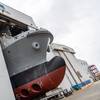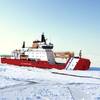Vessel’s Support Illustrates Importance
In addition to supplying ships such as the NORTHERN LIGHTS for military service, the Jones Act fleet contributes experienced seafarers to help crew ships activated from the U.S. government’s organic sealift fleet. Recent activations from that fleet include large, roll-on/roll-off vessels from the U.S. Navy’s surge sealift force and 13 vessels from the U.S. Maritime Administration’s Ready Reserve Force (RRF). These ships have joined the 19 RRF ships previously activated for Operation Enduring Freedom. The Jones Act and other U.S. maritime cabotage laws require that cargo and passengers moving between U.S. ports be carried in vessels that are U.S.-owned, -built and –crewed. Similar statutes govern other domestic maritime activities such as towing, dredging and marine salvage. Nationwide, the Jones Act fleet numbers more than 37,000 vessels of all types and generates some 125,000 jobs, 80,000 of which are aboard vessels. Jones Act vessels represent the vast majority of ships flying the U.S. flag. More than 80 percent of all U.S.-flag tankers are engaged in the Jones Act trades. Half of all U.S.-flag roll-on/roll-off ships and 34 percent of American-registered containerships work the Jones Act trades. Jones Act vessels account for 87 percent of shipboard jobs for American mariners. “The employment opportunities that the Jones Act trades create are crucial to our national defense capabilities,” Grill continued. “During the Bosnian conflict, 70 percent of the U.S. seafarers activated for military service had served on Jones Act ships.” “While it is appropriate to focus on the contributions of American ships and crews, we must also remember that a modern shipyard industrial base is critical to the nation’s military strength,” Grill further noted. “Jones Act vessels represent three-quarters of all commercial building opportunities and sustain the shipyards and repair facilities the Navy needs to modernize and expand its fleet of warships and auxiliary vessels. There are nearly 130 large vessels of all types currently under construction for the domestic trade and these hulls have a combined market value of $3.4 billion.” The U.S. military has long placed a high value on the Jones Act and the infrastructure it supports, because in time of crisis, ships transport nearly 95 percent of the arms and materials needed in a war zone. 1n 1998, the Navy determined it would need “hundreds of millions of additional dollars” in its annual appropriation to replace the U.S.-flag merchant marine and related industries engaged in domestic waterborne commerce. “[T]he U.S.-owned, U.S.-built and U.S.-crewed requirements levied by the Jones Act ... ensure that our country has a ready pool of assets and mariners, and an industrial base, which are vital to preserving our national security,” declared The Honorable John Douglass, then the Assistant Secretary of the Navy. The Maritime Cabotage Task Force was founded in 1995 to promote the U.S.-flag fleet engaged in domestic waterborne commerce. With more than 400 members, it is the largest U.S.-flag maritime coalition ever assembled. Nationwide, 37,000-plus vessels compete in the various Jones Act trades and annually carry more than 1 billion tons of cargo and 100 million passengers. Since 1965, the Jones Act fleet has tripled in size and quadrupled its productivity. So efficient is the fleet that it moves 24 percent of the country’s domestic cargo for less than 2 percent of the nation’s freight bill.













